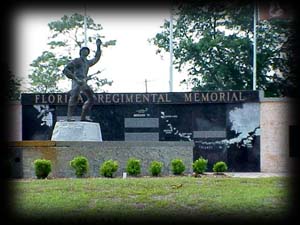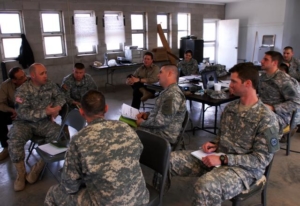Camp Blanding owes its location on the shore of Kingsley Lake to the US Navy’s desire to establish a Naval Air Station (NAS) on the banks of the St. Johns River, south of Jacksonville. The site was already the location of the Florida National Guard’s Camp Foster and negotiations were started for a land swap. In mid 1939, the transaction was accomplished and the state armory board chose as compensation a tract of 30,000 acres in Clay County as a National Guard camp and training site. The National Guard Officers Association of Florida recommended the new camp be named in honor of Lt General Albert H. Blanding. The War Department agreed and Camp Blanding’s history began.
General Blanding (9 Nov 1876 through 26 Dec 1970) was one of Florida’s most distinguished soldiers. He graduated from the East Florida Seminary (now the University of Florida) in 1894 and began his military service to the state and nation. He was promoted to Colonel in 1909 and commanded the 2nd Florida Infantry during the Mexican Border Service in 1916 and 1917. During World War I, he commanded the 53rd Brigade, 27th Division. He was promoted to Major General in 1924 and commanded the 31st Infantry Division until 1940. He also served as Chief of the National Guard Bureau until his retirement and promotion to Lieutenant General in 1940.
In 1940, Camp Blanding was leased to the Army as an active duty training center. The post was originally used by New England and Southern troops preparing for deployment overseas. However, during the course of the war, Camp Blanding served as an infantry replacement training center, induction center, prisoner of war compound, and a separation center. At the height of the war, thanks to leases with local landowners, Camp Blanding sprawled over more than 170,000 acres. From 1940 to 1945, more than 800,000 soldiers received all or part of their training here.
After the war, the state’s 30,000 acres was returned to the Armory Board and by 1948 most of the buildings were sold and moved off post. In the early 1950s the Federal Government deeded additional land to the state for use as a National Guard training facility, but until 1970 the post saw only limited use by the military.
In the 1970s an expansion program began upgrading the post facilities and in 1981, the Federal Government redesignated Camp Blanding as a Class A military installation. The designation qualified the post for use by greater numbers of troops with more diversified training. Upgrading facilities and training areas continues today.
In 1983, the first 105mm artillery firing points were used since World War II. Tank ranges have been upgraded and Tank Tables I through VI can be fired. In addition to improved facilities and ranges, a parachute drop zone and an airfield have expanded Camp Blanding’s training capacity and the Navy utilizes a bombing and staffing target in the southern portion of the post.
The E.I. du Pont de Nemours and Company, mines a restricted area on the western edge of the post where illuminate and other heavy minerals are removed from the soil. The Armory Board used the income from sale of mineral rights and timber products for general post maintenance, operations, and improvements. To help preserve the environment, DuPont has instituted a procedure whereby the topsoil is stripped and stock piled before mining operation. After mining the topsoil is redistributed over the mined area to help the return of vegetation.
Today Camp Blanding is a vibrant military installation with a training schedule that continues almost year round to meet the training needs of tens of thousands of National Guardsmen, Active Army and Reservists from all over the United States.


